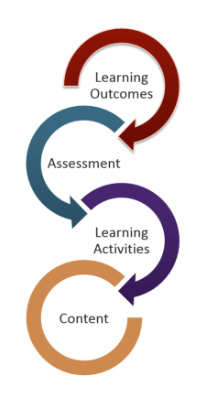Course and Instructional Design

Teaching online involves more deliberate planning, or design, compared to traditional teaching. Before you begin developing a site in Blackboard, you’ll need to analyze your particular teaching situation to make decisions to help your students learn what you want them to learn. One useful instructional design model for both online and face-to-face settings is called backward design (Fink, 2013; Wiggins & McTighe, 2005).
Backward Design
Backward design is an approach to designing curriculum and instruction to promote student understanding. Wiggins and McTighe (2005) suggest that we reverse the stages in traditional design by following three stages in backward design:
- Identify desired results - What should students know and be able to do?
- Determine acceptable evidence - How will we know if students have achieved the results?
- Plan learning experiences and instruction - What activities will equip students with the needed knowledge and skills?
Similarly, Fink (2013) describes the steps of backward design as making three sets of decisions in response to the following questions:
1) What do you want your students to learn?
2) How will students (and the teacher) know if they are learning?
3) What will the teacher and students need to do for students to learn?
Backward design is useful in designing your online course or learning resource because it helps you align (Wiggins & McTighe, 2005) and integrate (Fink, 2013) your design before you begin developing it. Constructive alignment (Biggs & Tang, 2011) between learning outcomes, assessment, and learning activities help you design for high quality university teaching, no matter what mode of delivery you choose.
If you want to know more about course design for online, hybrid, or open courses, contact the team at Open Learning, or sign up for one of our workshops and courses.
- Biggs, J. & Tang, C. (2011). Teaching for quality learning at university (4th ed.) NY: Open University Press.
- Fink, L. D. (2013). Creating significant learning experiences, revised and updated: An integrated approach to designing college courses. San Francisco, CA: Jossey-Bass.
- Wiggins, G. & McTighe, J. (2005). Understanding by Design (2nd ed.). Alexandria, VA: ASCD.
- This content is adapted from Indiana University’s Teaching Online: https://canvas.ucdavis.edu/courses/34528/pages/course-planning-with-backward-design offered under a CC Attribution Non-Commercial Share Alike license.
